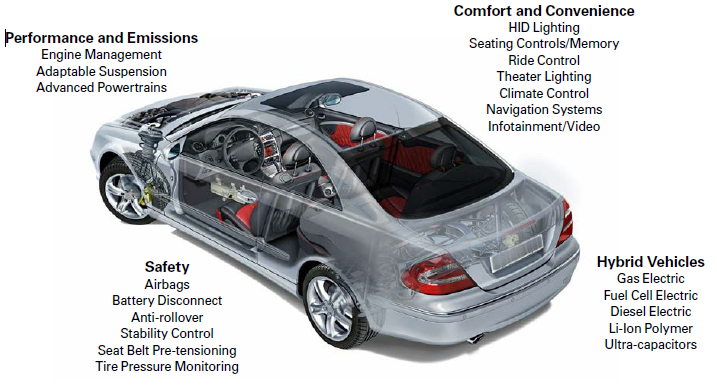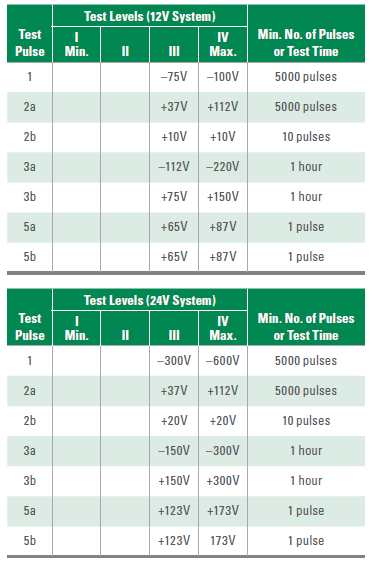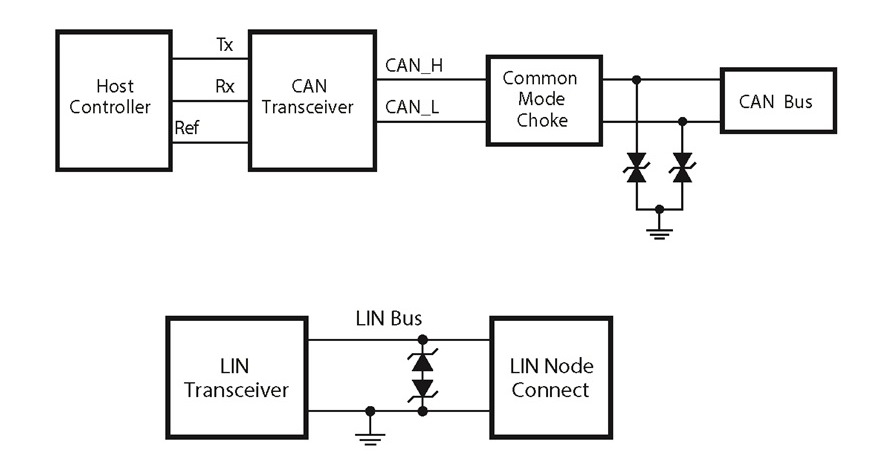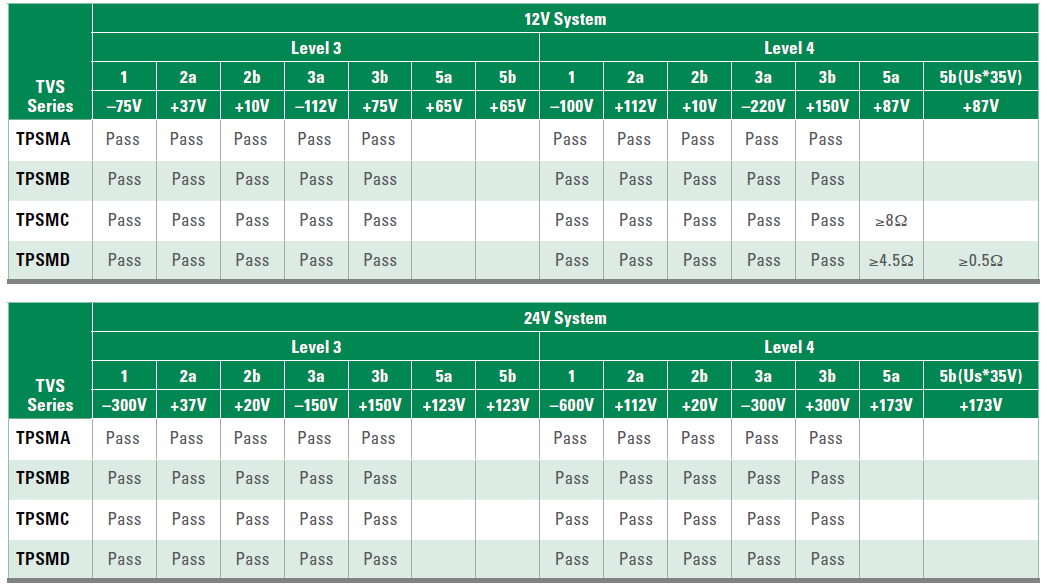Eliminate transient surges & enhance vehicle safety
What you need to know about using high-reliability TVS diodes for robust automotive circuit protection.
By Teddy To and Charlie Cai, Littelfuse, Inc.
Designing automotive electronics involves numerous technical challenges including the need to protect against electrical hazards. There are three major sources of electrical hazards in automotive systems: ESD; switching loads in power electronics circuits; and lightning. Overcoming these transient surges that can harm the vehicle’s electronics, whether under the hood or in the cabin, is one of the biggest obstacles of system design.
This article will help designers of automotive electronics better understand how to eliminate transient surges and enhance the overall safety of the vehicles. Readers will learn more about the vehicle systems subject to transient surge hazards and the established automotive test standards for transient surge protection. The article also discusses practical solutions for eliminating transient surges, including automotive bus standards/protection schemes and TVS diodes that deliver superior electrical performance in a small footprint.
Alternators: the primary source of transient surges
In modern automotive designs, all on-board electronics are connected to the battery and the alternator. Due to its instability, the output of the alternator requires further conditioning before it can be used to power the vehicle’s other systems.
Currently, most alternators have zener diodes to protect against load dump surges. However, these devices are insufficient. During the powering or switching of inductive loads, the battery is disconnected - generating unwanted spikes/transients (also known as load dump). If left uncorrected, these transients would be transmitted along the power line, causing individual electronics and sensors to malfunction or permanently damaging the vehicle’s electronic system, affecting overall reliability. Therefore, the alternator causes most of the transients in a vehicle’s electrical system.
Vehicle systems impacted by transient surge hazards
As shown in Figure 1, transient surge protection is needed for circuits and components located within four main categories of vehicle systems: safety, performance and emissions, hybrid vehicles and comfort and convenience.

Figure 1 - Vehicle systems vulnerable to transient surge hazards
Protecting the vehicle’s performance and safety systems are vital to ensuring the safety and well-being of the driver and passengers. However, human safety could also be compromised if uncontrolled transient surges and extreme temperatures create fires within any system of the vehicle.
While comfort and convenience systems may not be considered essential to the basic functionality of the vehicle, considerable expense and aggravation are associated with replacing these systems if damage occurs. For example, a recent report from IHS explained that infotainment systems now account for as much as 10% of the price of buying a new vehicle. Just imagine the significant cost of parts and labour involved in replacing a damaged infotainment system. As consumers become more dependent on features like navigation and video, they will not want to be inconvenienced by failures within these systems.
Test standards for automotive systems
The Automotive Electronics Council (AEC) Component Technical Committee has established test standards to provide strict guidelines for manufacturers to follow when designing, producing and testing vehicles. The AEC was created by Chrysler, Ford and GM to establish common part-qualification and quality-system standards. One of two AEC committees, the Component Technical Committee establishes series of AECQ standards for reliable, high-quality electronic components. Components that meet AECQ standards are considered suitable for use in harsh automotive environments without requiring additional component-level qualification testing.
The ISO 7637-2 standard, which covers a series of surge pulse and load dump test conditions, is widely used by the major automotive manufacturers around the world. This article will introduce the various test levels of this international standard.
Environment test levels for automotive systems
The following list outlines the different test pulses in the ISO 7637-2 standard, which simulate several stressful conditions inside the vehicle and its systems.
Test pulse definitions:
- Pulse 1 is a transient caused by battery supply disconnection from inductive loads;
- Pulse 2a simulates transients due to sudden interruption of currents in a device connected in parallel with the DUT due to the inductance of the wiring harness;
- Pulse 2b simulates transients from DC motors acting as generators after the ignition is switched off;
- Pulse 3a and 3b are switching transients;
- Pulse 5a and 5b are load dump transients. 5b, which is the clamp voltage, is defined by different car manufacturers;
- The former levels I and II were deleted in the table below because they do not ensure sufficient immunity in road vehicles; and
- Four performance levels for each pulse:
- Different o/c voltage;
- Negative and positive;
- Pulse duration 0.1–400ms;
- Single and burst; and
- TVS protection and its operation mode.

Table 1 - ISO7637-2 test levels on each pulse
TVS diodes provide superior electrical performance
For optimal performance, choose TVS diodes that provide secondary transient voltage protection from transients induced by load dump and other transient voltage events. These diodes offer superior electrical performance in a small footprint package, allowing designers to upgrade their circuit protection without altering their existing design footprint or to provide more robust protection in new circuit layouts. In addition, TVS diodes help the design pass the different tests specified by ISO 7637-2.
The following section explores the most common communications bus standards and identifies the ideal TVS diode for the application.
Automotive bus protection
Today’s most popular communication bus standards are the Controller Area Network (CAN) and Local Interconnect Network (LIN) busses:
- CAN
- The CAN bus is a vehicle bus standard designed to allow MCUs and devices to communicate within a vehicle - without the use of a host computer. Its message-based protocol is specifically designed for automotive applications. It is also used for aerospace, industrial automation and medical equipment applications;
- The high-speed CAN bus supports two data-speed versions. They are ideal for high-speed (1.0Mb/s) and medium-speed (125Kb/s) applications in harsh environments; and
- CAN systems handle everything from power steering to the critical drive-train communications between the transmission and engine’s computer..
- LIN
- The LIN bus standard is a serial network protocol used for communication between components in vehicles. As the technologies and the facilities implemented in vehicles grew, a need arose for a cheap serial network because the CAN bus was too expensive to implement for every component in the car;
- LIN systems handle simple electromechanical functions such as moving the power seats and toggling the cruise control;
- LIN buses may also be used over the vehicle’s battery power line with a special DC-LIN transceiver, which is common in today’s automotive world.
Because CAN/LIN busses are two-wire communication busses for controlling and monitoring various functions inside the car, their wires have a high chance of surge exposure - causing failure on the CAN/LIN transceivers. Consider the following protection methods for these busses.

Figure 2 - CAN bus and LIN bus protection using TVS diodes
As shown in Figure 2 (top), a TVS diode is designed to protect the two CAN bus lines in common mode (with a 24V system) from surge events. A 600W bi-directional TVS diode with 25.6V reverse standoff voltage and 41.4V maximum clamping voltage is ideal for protecting the CAN bus without clipping the CAN signals.
A LIN transceiver has signal ranges from +24 /–15V and data rates of 2.4 to 20kb/s. As seen in Figure 2 (bottom), it needs a bidirectional asymmetrical TVS configuration to protect the two wires in a differential mode.
Multiple TVS diodes can be connected in anti in-series mode to protect the two wires from surge events. An alternative solution that offers the same power handling capability involves adding a bi-directional TVS diode to protect the LIN bus.
ISO 7637-2 surge test results for automotive TVS diodes
The compliance of each level of the ISO 7637-2 surge test in 12 and 24V power systems when using various automotive TVS diodes are shown in Table 2. The diodes in the table feature pulse power ratings of 600, 600, 1500 and 3000W, respectively. These devices help the power system pass the different surge tests (1, 2a, 2b, 3a, 3b, 5a and 5b) operationally as specified by ISO 7637.
In the 12V system, when the diode is designed to pass the higher energy 5a surge, a series resistance of more than 8Ω must be added on the power line. This also applies to the 5b surge, where a series resistance of more than 0.5Ω is required to pass the test operationally. For the 24V car power system surge compliance, refer to the 24V system results in Table 2.

Table 2 - Automotive TVS diode compliance with various surge levels in 12/24V powertrains (Source: Littelfuse)
Because of the electrical vulnerabilities within the primary vehicle systems, due diligence is required in protecting against electrical hazards - especially transient surges caused by load dump, ESD or lightning. To ensure the safety of vehicle occupants and safeguard the owner’s investment in the vehicle, international and American test standards offer strict guidance for protecting against the damaging effects of transient surges. Today, the best transient surge protection is provided by automotive TVS diodes that deliver proven, high-reliability performance in a small footprint.
Author bios:
Teddy To is the global technical marketing manager of Littefuse, Inc. based in Hong Kong. He is also the manager of the team of application engineers and the global technical centre. Since joining Littelfuse in 2003, he has held multiple positions, including global segment marketing and product manager.
Charlie Cai is the global product manager of automotive TVS and high-reliability TVS diodes in the Semiconductor Business Unit. He joined Littelfuse as an inside product manager in 2009. His current responsibilities include managing product line strategies, P&L, new applications and new products. He received his BSEE from Soochow University in 2011.











